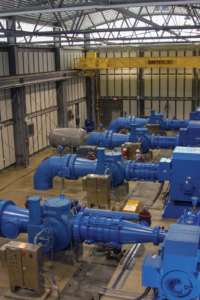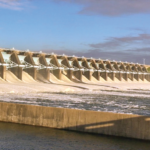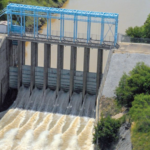T
he Tarrant Regional Water District (TRWD) has been providing flood control and water supply services to the city of Fort Worth, Texas, for nearly 100 years. In a swiftly growing urban area that has experienced significant dry and wet spells over the past 4 years, it is imperative to be able to forecast future supply and demand and to plan on that basis.
As TRWD’s water resources engineering director, Rachel Ickert oversees energy and water supply management as well as flood control operations for the district. In this interview with Municipal Water Leader Managing Editor Joshua Dill, Ms. Ickert discusses her department’s responsibilities and how the department integrates the newest research and computer modeling information into its operations.
 Joshua Dill: Please tell us about your background and how you ended up in your current position.
Joshua Dill: Please tell us about your background and how you ended up in your current position.
Rachel Ickert: I grew up in the Texas Panhandle with an appreciation for water. Starting at an early age, I had an interest in math and science that my parents, grandparents, and teachers recognized and fostered. I hold a bachelor’s degree in civil engineering from Texas Tech University and a master’s degree in civil engineering with an emphasis on water resources from the University of Texas at Arlington. After college, I went into consulting and worked for Freese and Nichols, Inc., for 11 years. During my time there, I worked on water transmission design, water rights permitting, and regional water supply planning, specifically in the north Texas area we called Region C, which is where I continue to work today. I also worked on various projects for TRWD, including operational studies, pipeline and pump design, construction management, and water supply planning.
Almost 5 years ago, I came to work for TRWD. My initial title when I came to the district was a special projects director. I was primarily responsible for getting our asset management program started. Today, I am still overseeing that process, but at this point, there are many other people involved.
Almost 1 year into my time at TRWD, I became the water resources engineering director, which is my current position. I have been in this position for just over 4 years. We basically formed a new department by dividing the existing engineering department into a water resources engineering department and an infrastructure engineering department. Geospatial services, which includes surveying and GIS, were added to the new water resources engineering department.
In both water supply and flood operations, the last 4 years have been pretty interesting. The years 2015 and 2016 brought floods to our area. That was a significant challenge. On the water supply side, those floods ended a long, sustained drought that had been ongoing when I first arrived. I have seen some dry periods and some pretty wet periods.
TRWD owns and operates four reservoirs and also has flood and water supply operations responsibilities. My group is responsible for planning water supply operations and energy management as we move the water through the system. We work with our data sources and models to make decisions on how to move water in the most efficient way possible.
 Joshua Dill: How would you describe what a water resources engineering director does?
Joshua Dill: How would you describe what a water resources engineering director does?
Rachel Ickert: The primary responsibility is to lead the division and personnel in flood monitoring and water supply operations planning, which includes an annual pumping power budget of $20 million. Water supply management and the associated energy management and coordination with our customers’ water treatment plants are the primary focus areas with ongoing, real-time needs. Flood-operations management becomes a high priority role when our reservoirs are spilling. We also provide technical support and project management for the district’s long-range water supply planning, which is led by our planning director.
Joshua Dill: Would you tell us a little bit about the district, especially what sets it apart from other districts?
Rachel Ickert: From what I have learned in networking with other agencies and from articles I have read, TRWD is different from other districts because of our innovative approaches and because we are a raw water supplier with a large water transmission infrastructure. We do not treat water for drinking. We manage raw water source reservoirs and deliver the water to our customers’ water treatment plants; they treat the water and deliver it to the appropriate end users. Our flood control responsibilities set us apart as well. Our reserviors are water supply reservoirs, not flood control reservoirs. However, they do have some flood control capability. Our two West Fork reservoirs sit upstream of the Fort Worth Floodway, which includes 27 miles of levees that were built by the U.S. Army Corps of Engineers along the Trinity River to provide vital flood protection to area residents and businesses. As the local sponsor of the floodway, we have operations and maintenance responsibilities for those levees and work in coordination with the Army Corps.
Joshua Dill: Would you tell us about water resources forecasting and the difficulties of that process?
Rachel Ickert: We have long-term forecasts that help us project our needs and plan how to move water within our system. Our reservoirs are spread out geographically. Our Bridgeport and Eagle Mountain Reservoirs, which are located north and west of Fort Worth, fall into our West Fork System. We also have reservoirs in east Texas—the Richland-Chambers and Cedar Creek Reservoirs—which are further downstream in the Trinity basin. Those two reservoirs are much larger than the reservoirs closer to our end users: They hold 80–85 percent of our water supply. We have to spend a lot of money to pump that water uphill and across many miles to the Fort Worth and Arlington area, where our primary demand is located. There are water treatment plants that pull from our reservoirs, and we want to make sure that those reservoirs have enough water to meet their demands. Our system cannot pump the water in real time to meet the water treatment plants’ demands, so we always need to be planning ahead. We always want to be ahead of the game and to have water in storage.
On the flood-operations side, we have a longer-term forecast that indicates whether we are moving into a wetter or drier climate. However, it is the short-term forecasts that we are watching when responding to flood conditions. The forecasts are hardly ever exactly right, but they are good at letting us know when water can be expected. However, we do not make our flood-operations decisions until we see how much water is on the ground. By that, I mean that once the rainfall hits and is measured, we know where the water is, and we can decide how best to respond to the effects. We watch the forecasts to get an idea of what else to expect, but actual reservoir discharge decisions are made based on the water on the ground. The forecasting is important, but in some instances, we still have to wait to see if the projections are accurate to act on them.
Joshua Dill: Would you talk about the relationship between the academic side and the practical side of water resources management?
Rachel Ickert: We are on the leading edge of our field, and we are constantly looking for new and innovative ways to manage our operations. Where appropriate, we integrate new ideas with tried and true methods and applications. We are involved in multiple research projects with the Water Research Foundation, and we have also worked with several universities.
The University of Texas at Arlington helped us on a flood planning project by modeling future flows during large storms. They did this by moving storms around in their computational models. That information helped us go back and check some of the work we had done previously. We completed that study in conjunction with the Army Corps. We have a sophisticated flood-operations model as well as a RiverWare river system model that we use for our water supply operations. Those models, combined with our experience and practical knowledge, help guide our decisions.
Joshua Dill: Would you speak about your experience as a woman in the water industry?
Rachel Ickert: I started in civil engineering at a time when I was close to being the only female in my classes. The ratio was about 10 percent women to 90 percent men at Texas Tech. Statistics show that there are more women coming into the field now. It is important for everyone to support each other, but it is especially important for women to reach out to other women in the field. I have been fortunate to have had a lot of great mentors and supervisors throughout my career. My husband, who is also an engineer, has been my biggest supporter. When I look back over my career thus far, I would say that as many women as men have supported me along the way. It is really important to pay that forward by mentoring and supporting other engineers and youth who may be interested in engineering.
For me, it was not really a challenge to be a woman in my field until I became a mother. At that time, it was highly important for me to have female mentors that had gone through the transition successfully. I was fortunate in that the people I worked for were supportive of a flexible schedule. I actually worked part time for several years. I am very much in favor of allowing other people to do that if they can do it successfully; I think it shows character when someone values their family life enough to want to make those adjustments to their work life. Allowing that kind of flexibility also earns an employer more loyal employees.
Joshua Dill: What is most rewarding about your current position?
Rachel Ickert: The primary reason I came to work for TRWD was the opportunity to serve our community and the public. It is nice to be able to see the effects of our efforts. It is a great place to work, and I am glad to be able to serve in this capacity. I also really enjoy the people with whom I work and our innovative projects.
Joshua Dill: What is your vision for the future?
Rachel Ickert: We have a lot of initiatives underway that I am looking forward to seeing through. Our population is expected to continue to increase, and water needs will continue
to increase as well, even with water conservation and changes in water use behavior. As demand increases, we will ultimately need more water sources. We are studying our projected water demands to get a better idea of what to expect, and we are pursuing projects to optimize the water resources we already have, such as an aquifer-storage-and-recovery demonstration well and reclaimed water studies. We will continue to work with our regional partners to optimize all our systems and resources as well.
Rachel Ickert is the water resources engineering director at Tarrant Regional Water District. She can be contacted at rachel.ickert@trwd.com.


